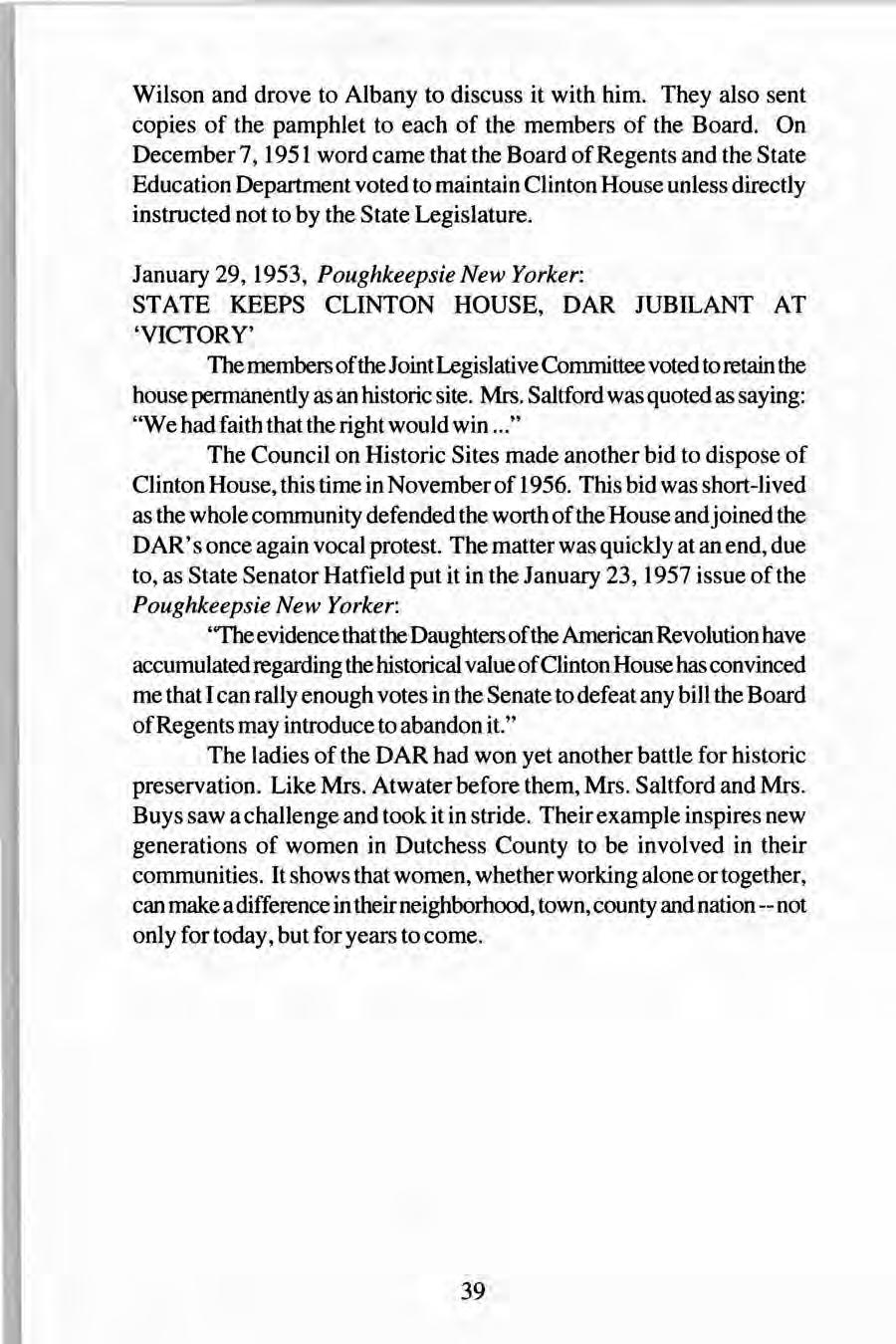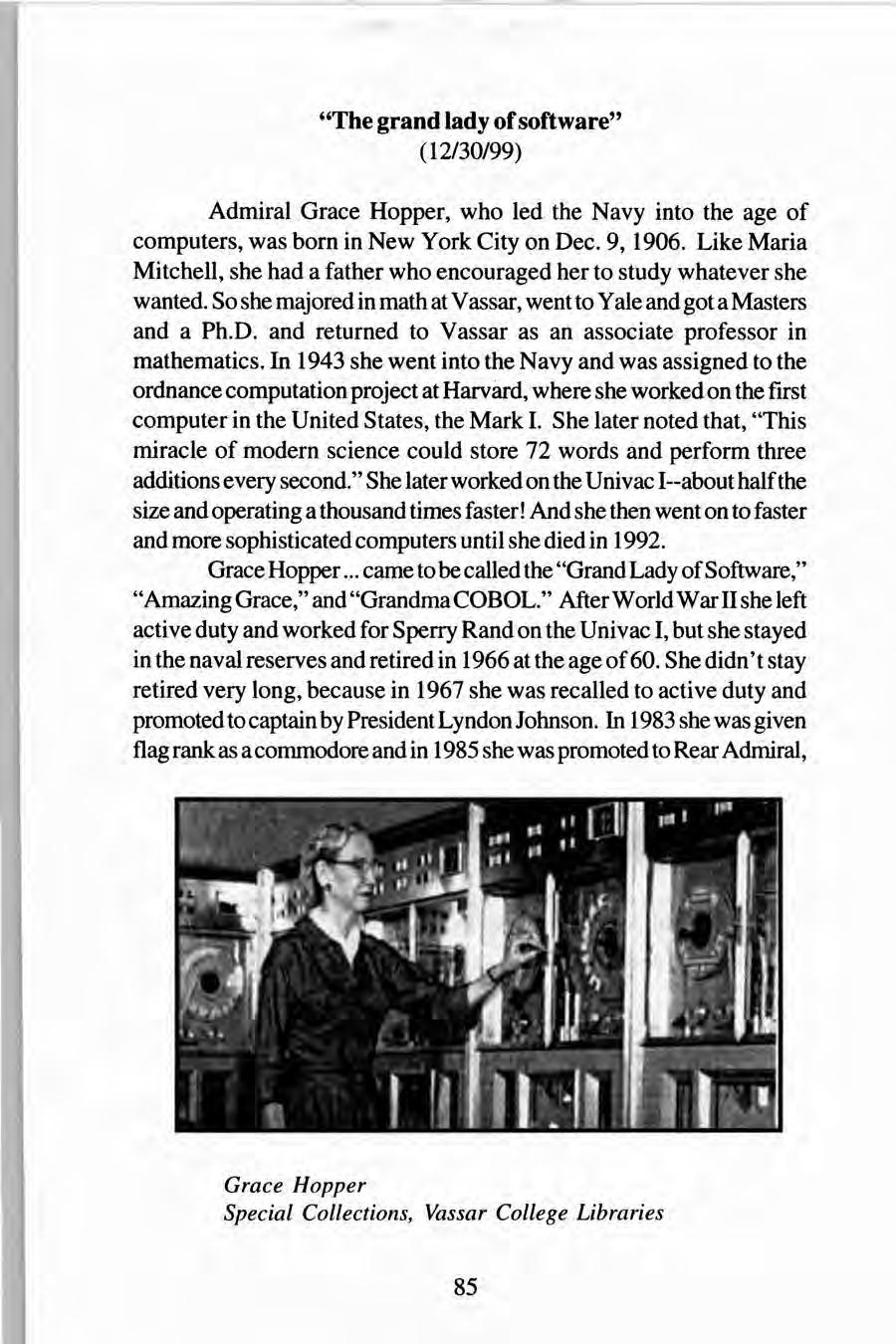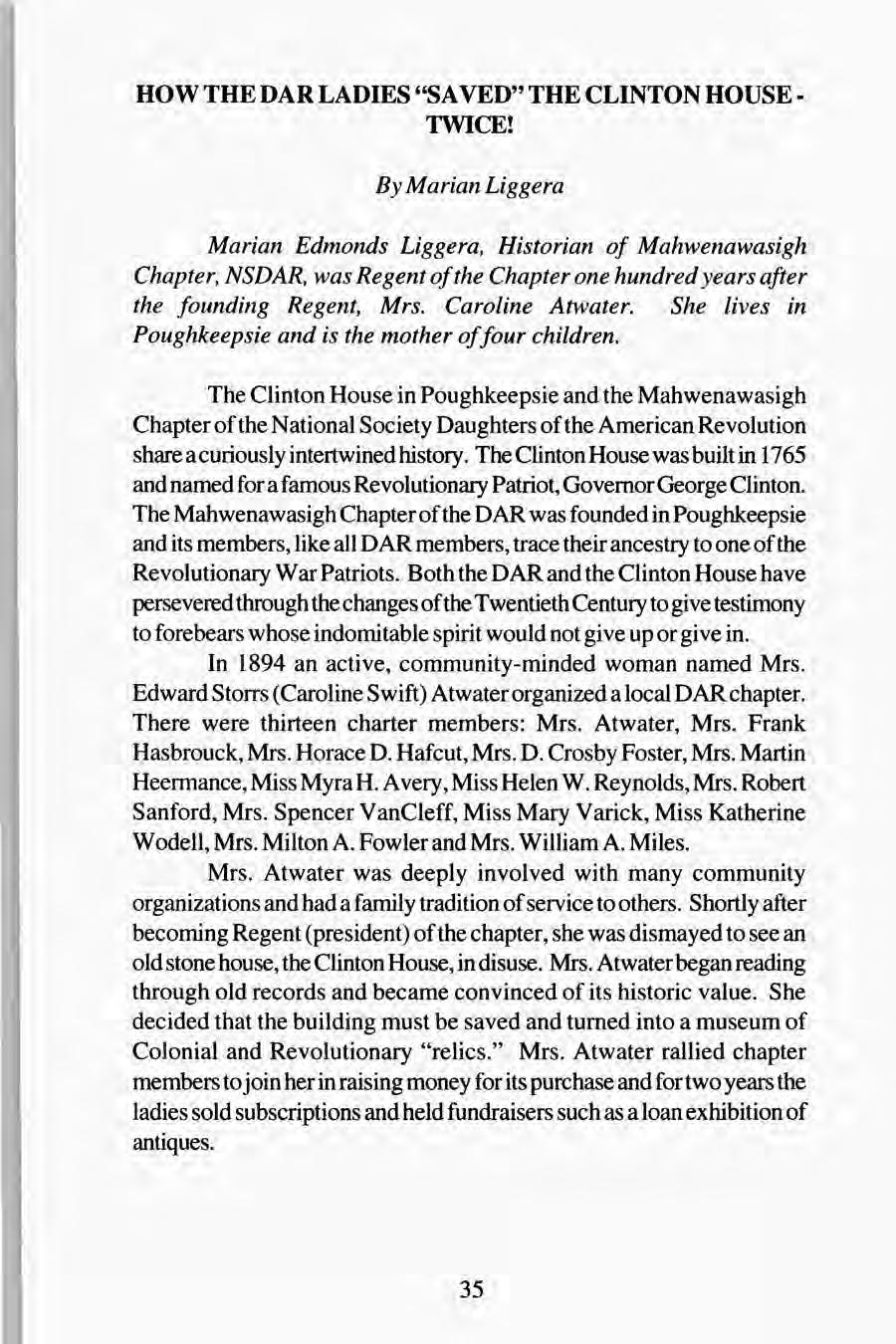
9 minute read
How the D.A.R. Ladies "Saved" the Clinton House--Twice
HOW THE DAR LADIES "SAVED" THE CLINTON HOUSE TWICE!
By Marian Liggera
Marian Edmonds Liggera, Historian of Mahwenawasigh Chapter, NSDAR, was Regent of the Chapter one hundred years after the founding Regent, Mrs. Caroline Atwater. She lives in Poughkeepsie and is the mother of four children.
The Clinton House in Poughkeepsie and the Mahwenawasigh Chapter of the National Society Daughters of the American Revolution share a curiously intertwined history. The Clinton House was built in 17 65 and named for a famous Revolutionary Patriot, Governor George Clinton. The Mahwenawasigh Chapter of the DAR was founded in Poughkeepsie and its members, like all DAR members, trace their ancestry to one of the Revolutionary War Patriots. Both the DAR and the Clinton House have persevered through the changes of the Twentieth Century to give testimony to forebears whose indomitable spirit would not give up or give in. In 1894 an active, community-minded woman named Mrs. Edward Storrs (Caroline Swift) Atwater organized a local DAR chapter. There were thirteen charter members: Mrs. Atwater, Mrs. Frank Hasbrouck, Mrs. Horace D. Hafcut, Mrs. D. Crosby Foster, Mrs. Martin Heermance, Miss Myra H. A very, Miss Helen W. Reynolds, Mrs. Robert Sanford, Mrs. Spencer VanCleff, Miss Mary Varick, Miss Katherine W ode 11, Mrs. Milton A. Fowler and Mrs. William A. Miles. Mrs. Atwater was deeply involved with many community organizations and had a family tradition of service to others. Shortly after becoming Regent (president) of the chapter, she was dismayed to see an old stone house, the Clinton House, in disuse. Mrs. Atwater began reading through old records and became convinced of its historic value. She decided that the building must be saved and turned into a museum of Colonial and Revolutionary "relics." Mrs. Atwater rallied chapter members to join her in raising money for its purchase and for two years the ladies sold subscriptions and held fundraisers such as a loan exhibition of antiques.
The Poughkeepsie Daily Eagle, Friday, January 21, 1898 reported: OLD STONE HOUSE PURCHASED By Syndicate for Daughters of the Revolution (sic) "It has been rumored several times that the local chapter of the Daughters of the Revolution had carried out their plan of purchasing the only building in Poughkeepsie of real historic associations and now the announcement is definitely made that a syndicate has purchased it in the interest of the chapter. The building stands at the corner of Main and White Streets, not a very promising location for a historical museum. It should have been built on some one of the bluffs in the lower part of town that commanded a fine view of the river, but as Governor George Clinton had the bad taste to live way out there when there was so much good land along the river, there is nothing more to be said. It will be a considerable gain to redeem the building from the disreputable uses to which it has so long been put."
The Chapter was able to purchase the property from Mr. Charles Kirchner for $7,000, a sizable portion of which was "forgiven" by Mr. Kirchner, as he was convinced that their purchase of the House would enhance the value of his neighboring properties. Members dedicated themselves to lovingly refurbishing and furnishing the "Clinton Museum." Donations of furnishings were requested, and within two days 800 pieces of furniture and antiques were received. A formal opening was held May 25, 1898, but it was a simple affair due to the Spanish-American War. In 1899, however, the Chapter was having financial difficulty managing the upkeep of the property. It was decided that a committee should be formed to incorporate and hold title to the property on behalf of the Chapter. This was accomplished in April when Mrs. Atwater, Frank Van Kleeck and Tristram Coffin obtained the title to the property with a $5,000 mortgage at 4% from the former owner, Mr. Kirchner. Judge Hasbrouck, with the consent of the Court, incorporated the "syndicate," with their stated object being "Patriotic, Educational and Historical" --also the object of the DAR. In July 1900, New York State purchased the mortgage with a $5,000 appropriation. The bill was signed by Governor Theodore Roosevelt, with a verbal agreement that the building would continue to be used as a "Museum of Relics." The State Taconic Park Commission had jurisdiction over the property, which was maintained with a stipend from the State and operated by the DAR.
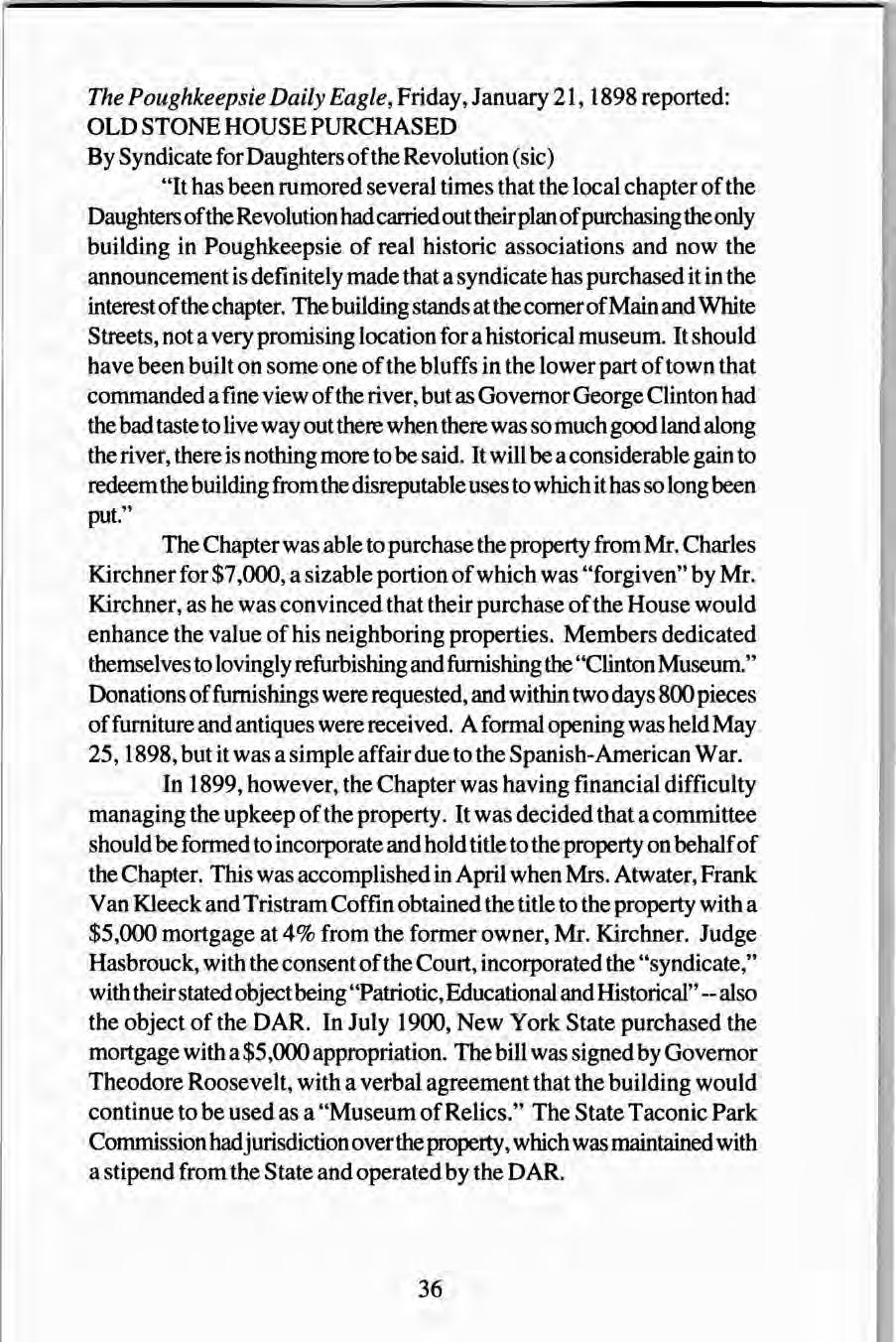
Mahwenawasigh Chapter members continued their restoration work, with a 1902 motion that "the conservatory be removed and a new kitchen be built" at a cost of$500. In 1914 the 75-year old mansard roof was replaced with a Revolutionary-style gable roof. Members spent three months with Mr. Vought of the New York State Architects office, poring over records and studying other stone houses with the goal of returning the building to its Revolutionary form. During these investigations eight open fireplaces were uncovered and two original mantles were discovered in the attic.
While the restoration continued, members were also busy with work for the War Effort. Every Wednesday, five sewing machines were operated with the result of hundreds upon hundreds of pajamas, robes, comfort bags, splint pillows and piles of knitted garments. Mrs. Atwater' s daughter, Evelyn Atwater Cummins, was now a chapter member and she was busy organizing many of the activities as well as driving an ambulance. In January of 1921 work was complete enough that a formal opening of the "Clinton Mansion" was held. Despite inclement weather, Main Street was lined with waiting motorcars drawn up to the curb on Main Street. Guests were treated to welcoming fires in the great open fireplaces and were serenaded by the Gibson Mandolin Club. The next thirty years proved fruitful for both the DAR and the Clinton House. Thousands of visitors came to the House, and Mahwenawasigh Chapter now had hundreds of members. One member, Mrs. W. Arthur (Belle) Saltford began an Occupational Therapy program at Ellis Island for ill immigrants. Her program achieved national acclaim, with model programs under her direction in Staten Island and California. World War II saw increased activity as members engaged directly in war activities, with a total of 36,000 hours and $125,000 in war bonds and stamps the output. On September 21, 1951, there came surprising news: the New York State's Joint Legislative Committee on Historic Sites listed Clinton House as one of ten holdings which should be "disposed of." It had been first reported by Helen Wilkinson Reynolds in the 1925 Year Book of the Dutchess County Historical Society that Clinton House had been built in 1765 by Hugh Van Kleeck, who lived there until selling it in 1780, thus disproving the popular theory that Governor Clinton had lived there. Dr. Henry Noble MacCracken, President Emeritus of Vassar College, also made the assertion in the spring of 1951 that Governor Clinton had never lived in Clinton House.
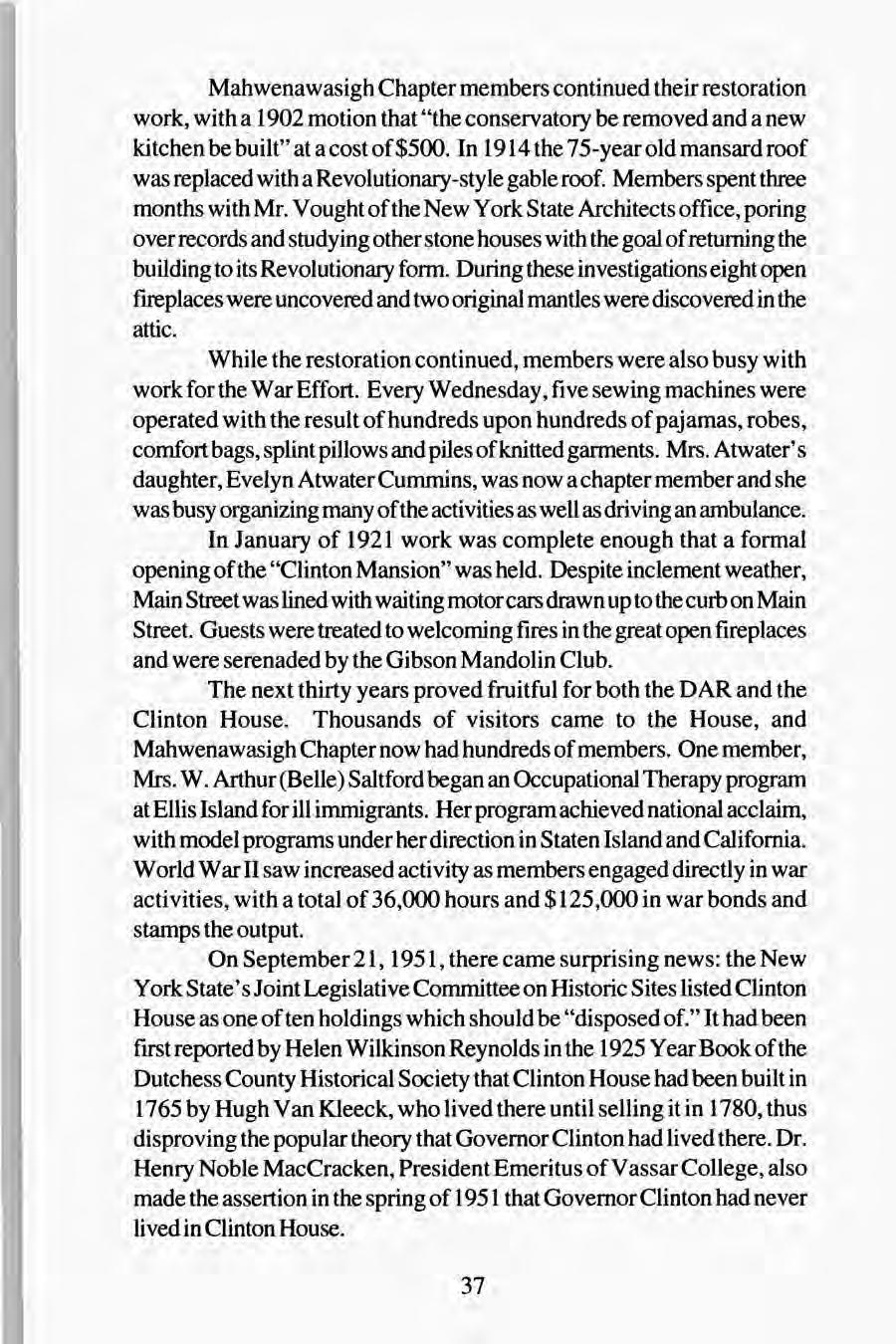
At this time, Mahwenawasigh Chapter was being led by a new regent, Mrs. Douglas C. (Barbara) Buys. Mrs. Buys, at the age of twentysix, was the youngest regent that the chapter ever had. Mrs. Buys made a fortuitous choice in appointing former regent and community leader Mrs. Saltford of Ellis Island fame to lead a special Clinton House committee. This committee was charged with the task of proving the House's worth to the New York State Historian, Albert B. Corey. Mrs. Saltford' s committee declared that they would show the state and national importance of Clinton House. The committee also set out to prove that New York State had amoral obligation to continue its agreement to maintain Clinton House as a state historical site. The DAR committee's first course of action was to sponsor a public meeting at Clinton House. They invited the State Historian, Mr. Corey, as well as all of the members of the Joint Legislative Committee on Historic Sites. The October 3, 1951 issue of the Poughkeepsie New Yorker featured Mr. Corey examining a spinning wheel, while Mrs. Saltford and Mrs. Buys looked on: "Stirring appeals for state retention of the house were made at the hearing. Leaders of the DAR Chapter were joined by city and county officials and other civic leaders in presenting the case for continued state recognition of the Revolutionary period house as having state and national importance. The DAR chapter has helped maintain the house during all of the period of 50 years it has been under state control. Mrs. W. Arthur Saltford, past regent of the DAR chapter, presided at the hearing, attended by an audience which filled the west room of the Clinton House main floor .... State Historian Corey and his associates of the State Education Department contended in a formal report the Clinton House had no significance from a state standpoint. Mr. Corey held out no immediate promise the state department would change its plan to dispose of the house and nine other historical sites in the state. Mrs. Saltford who summed up the position of the DAR chapter, declared she resented state officials handling of the entire matter." From the State's point of view, the matter was at a standstill until a review by the Board of Regents of the Education Department. Dr. Louis Wilson, State Commissioner of Education, was slated to present the question to the Board in December. Not being ones to wait idly by, Mrs. Saltford, Mrs. Buys and a few others prepared a pamphlet stating their case in defense of Clinton House. They then secured an appointment with Dr.

Wilson and drove to Albany to discuss it with him. They also sent copies of the pamphlet to each of the members of the Board. On December 7, 1951 word came that the Board of Regents and the State Education Department voted to maintain Clinton House unless directly instructed not to by the State Legislature.
January 29, 1953, Poughkeepsie New Yorker: STATE KEEPS CLINTON HOUSE, DAR JUBILANT AT
'VICTORY'
The members of the Joint Legislative Committee voted to retain the house permanently as an historic site. Mrs. Saltford was quoted as saying: "We had faith that the right would win ... " The Council on Historic Sites made another bid to dispose of Clinton House, this time in November of 1956. This bid was short-lived as the whole community defended the worth of the House and joined the DAR' s once again vocal protest. The matter was quickly at an end, due to, as State Senator Hatfield put it in the January 23, 1957 issue of the Poughkeepsie New Yorker: "The evidence that the Daughters of the American Revolution have accumulated regarding the historical value of Clinton House has convinced me that I can rally enough votes in the Senate to defeat any bill the Board of Regents may introduce to abandon it." The ladies of the DAR had won yet another battle for historic preservation. Like Mrs. Atwater before them, Mrs. Saltford and Mrs. Buys saw a challenge and took it in stride. Their example inspires new generations of women in Dutchess County to be involved in their communities. It shows that women, whether working alone or together, can make a difference in their neighborhood, town, county and nation --not only for today, but for years to come.
